Modeling the Effect of Desert Urbanization on Local Climate and Natural Dust Generation: A Case Study for Erbil, Iraq
Abstract
:1. Introduction
2. Numerical Models and Methodology
2.1. Meteorological Model and Boundary Conditions
2.2. Calculation of Surface Dust Fluxes
3. Setup of Numerical Simulations for Erbil
3.1. The Focus Location and Model Domain
3.2. Land-Use Land-Cover Maps
3.3. Lateral Boundary Conditions and Dynamical Downscaling
4. Results
4.1. Cross Validation with Reanalysis
4.2. Effect of Urbanization on Meteorological Fields
4.3. Surface Dust Fluxes
4.4. Influence of Meteorological Conditions on Dust Generation
5. Concluding Remarks
Author Contributions
Funding
Acknowledgments
Conflicts of Interest
References
- United Nations Environment Programme (UNEP). Global Deserts Outlook; United Nations Environment Programme (UNEP): Nairobi, Kenya, 2006; p. 164. Available online: https://www.unenvironment.org/resources/report/global-deserts-outlook (accessed on 1 July 2020).
- United Nations Department of Economic and Social Affairs. World Population Prospects; United Nations Department of Economic and Social Affairs: New York, NY, USA, 2018; p. 126. Available online: https://population.un.org/wup/Publications/Files/WUP2018-Report.pdf (accessed on 1 July 2020).
- Brazel, A.; Gober, P.; Lee, S.J.; Grossman-Clarke, S.; Zehnder, J.; Hedquist, B.; Comparri, E. Determinants of changes in the regional urban heat island in metropolitan Phoenix (Arizona, USA) between 1990 and 2004. Clim. Res. 2007, 33, 171–182. [Google Scholar] [CrossRef] [Green Version]
- Miller, J.A. Urban and regional temperature trends in Las Vegas and southern Nevada. J. Ariz. Nev. Acad. Sci. 2011, 43, 27–39. [Google Scholar] [CrossRef]
- Fan, C.; Myint, S.W.; Kaplan, S.; Middel, A.; Zheng, B.; Rahman, A.; Huang, H.-P.; Brazel, A.; Blumberg, D.G. Understanding the impact of urbanization on Surface Urban Heat Islands—A longitudinal analysis of the oasis effect in subtropical desert cities. Remote Sens. 2017, 9, 672. [Google Scholar] [CrossRef] [Green Version]
- Lazzarini, M.; Marpu, P.R.; Ghedira, H. Temperature-land cover interactions: The inversion of urban heat island phenomenon in desert city areas. Remote Sens. Environ. 2013, 130, 136–152. [Google Scholar] [CrossRef]
- Rasul, A.; Balzter, H.; Smith, C. Spatial variation of the daytime Surface Urban Cool Island during the dry season in Erbil, Iraqi Kurdistan, from Landsat 8. Urban Clim. 2015, 14, 176–186. [Google Scholar] [CrossRef] [Green Version]
- Kamal, S.; Huang, H.-P.; Myint, S. The influence of urbanization on the climate of the Las Vegas Metropolitan area: A numerical study. J. Appl. Meteorol. Climatol. 2015, 54. [Google Scholar] [CrossRef]
- Kamal, S.; Huang, H.-P.; Myint, S. Numerical simulations to quantify the diurnal contrast in local climate trend induced by desert urbanization. Environ. Syst. Decis. 2017, 13. [Google Scholar] [CrossRef]
- Kusaka, H.; Hara, M.; Takane, Y. Urban climate projection by the WRF Model at 3 km horizontal grid increment: Dynamical downscaling and predicting heat stress in the 2070′s August for Tokyo, Osaka, and Nagoya Metropolises. J. Meteorol. Soc. Jpn. 2012, 90B, 47–63. [Google Scholar] [CrossRef] [Green Version]
- Park, S.; In, H. Parameterization of dust emission for the simulation of the yellow sand (Asian dust) event observed in March 2002 in Korea. J. Geophys. Res. 2003, 108, 4618. [Google Scholar] [CrossRef]
- Choi, Y.-J.; Fernando, H. Implementation of a windblown dust parameterization into MODELS-3/CMAQ: Application to episodic PM events in the US/Mexico border. Atmos. Environ. 2008, 42, 6039–6046. [Google Scholar] [CrossRef]
- Rasul, A. Remote Sensing of Surface Urban Cool and Heat Island Dynamics in Erbil, Iraq, between 1992 and 2013. Ph.D. Thesis, University of Leicester, Leicester, UK, 2016. [Google Scholar]
- Faqe-Ibrahim, G. Urban Expansion Monitoring Utilizing Remote Sensing Tools in Erbil City-Kurdistan Region. Master’s Thesis, Soran University, Erbil, Iraq, 2013. [Google Scholar]
- Skamarock, W.; Klemp, J.; Dudhia, J.; Gill, D.; Barker, D.; Duda, M.; Powers, J. A Description of the Advanced Research WRF Version 3; National Center for Atmospheric Research: Boulder, CO, USA, 2008. [Google Scholar]
- Caldwell, P.; Chin, H.-N.; Bader, D.; Bala, G. Evaluation of a WRF dynamical downscaling simulation over California. Clim. Chang. 2009, 95, 499–521. [Google Scholar] [CrossRef] [Green Version]
- Heikkila, U.; Sandvik, A.; Sorteberg, A. Dynamical downscaling of ERA-40 in complex terrain using the WRF regional climate model. Clim. Dyn. 2011, 37, 1551–1564. [Google Scholar] [CrossRef] [Green Version]
- Pan, L.; Chen, S.; Cayan, D.; Hart, M.; Zhang, Q.; Liu, Y.; Wang, J. Influence of climate change on the California and Nevada regions revealed by a high-resolution dynamical downscaling study. Clim. Dyn. 2011, 37, 2005–2020. [Google Scholar] [CrossRef] [Green Version]
- Sharma, A.; Huang, H.-P. Regional climate simulation for Arizona: Impact of resolution on precipitation. Adv. Meteorol. 2012. [Google Scholar] [CrossRef] [Green Version]
- Lind, P.; Lindstedt, D.; Kjellström, E.; Jones, C. Spatial and temporal characteristics of summer precipitation over Central Europe in a suite of high-resolution climate models. J. Clim. 2016, 29, 3501–3518. [Google Scholar] [CrossRef] [Green Version]
- Chen, F.; Kusaka, H.; Borndtein, J.; Ching, J. The integrated WRF/urban modelling system: Development, evaluation, and applications to urban environmental problems. Int. J. Climatol. 2011, 273–288. [Google Scholar] [CrossRef]
- Kusaka, H.; Kondo, H.; Kikegawa, Y.; Kimura, F. A simple single-layer urban canopy model for atmospheric models: Comparison with multi-layer and slab models. Bound.-Layer Meteor. 2001, 101, 329–358. [Google Scholar] [CrossRef]
- Kusaka, H.; Kimura, F. Coupling a single-layer urban canopy model with a simple atmospheric model: Impact on urban heat island simulation for an idealized case. J. Meteor. Soc. Jpn. 2004, 82, 67–80. [Google Scholar] [CrossRef] [Green Version]
- Myint, S.W.; Zheng, B.; Talen, E.; Fan, C.; Kaplan, S.; Middel, A.; Smith, M.; Huang, H.-P.; Brazel, A. Does the spatial arrangement of urban landscape matter? Examples of urban warming and cooling in Phoenix and Las Vegas. Ecosyst. Health Sustain. 2015, 1, art15. [Google Scholar] [CrossRef]
- Zheng, B.; Myint, S.W.; Fan, C. Spatial configuration of anthropogenic land cover impacts on urban warming. Landsc. Urban Plan. 2014, 130, 104–111. [Google Scholar] [CrossRef]
- Hong, S.-Y.; Pan, H. Nonlocal boundary layer vertical diffusion in a medium-range forecast model. Mon. Weather Rev. 1996, 124, 2322–2339. [Google Scholar] [CrossRef] [Green Version]
- Hong, S.-Y.; Noh, Y. A New vertical diffusion package with an explicit treatment of entrainment processes. Mon. Weather Rev. 2005, 134, 2318–2341. [Google Scholar] [CrossRef] [Green Version]
- Laurent, B.; Marticorena, B.; Bergametti, G. Modelling mineral dust emissions. Earth Environ. Sci. 2009. [Google Scholar] [CrossRef]
- Westphal, D.; Toon, O.; Carlson, T. A Two-Dimensional numerical investigation of the dynamics and microphysics of Saharan dust storms. J. Geophys. Res. 1987, 92, 3027–3049. [Google Scholar] [CrossRef]
- Marticorena, B.; Bergametti, G.; Gillette, D.; Belnap, J. Factors controlling threshold friction velocity in semiarid and arid areas of the United States. J. Geophys. Res. 1997, 102, 23277–23287. [Google Scholar] [CrossRef]
- Fecan, F.; Marticorena, B.; Bergametti, G. Parameterization of the increase of the Aeolian erosion threshold wind friction velocity due to soil moisture for arid and semi-arid areas. Ann. De Geophys. 1999, 17, 149–157. [Google Scholar] [CrossRef] [Green Version]
- Gong, S.; Zhang, X.; Zhao, T.; Mckendry, I.; Jaffe, D.; Lu, N. Characterization of soil dust aerosol in China and its transport and distribution during 2001 ACE-Asia: 2. Model simulation and validation. J. Geophys. Res. 2003, 108. [Google Scholar] [CrossRef]
- USGS LandsatLook. Available online: www.landlook.usgs.gov (accessed on 16 November 2017).
- Saha, S.; Moorthi, S.; Pan, H.-L.; Wu, X.; Wang, J.; Nadiga, S.; Tripp, P.; Kistler, R.; Woollen, J.; Behringer, D.; et al. The NCEP Climate Forecast System Reanalysis. Bull. Am. Meteorol. Soc. 2010, 91, 1015–1057. [Google Scholar] [CrossRef]
- Rajagopalan, P.; Lim, K.; Jamei, E. Urban heat island and wind flow characteristics of a tropical city. Sol. Energy 2014, 107, 159–170. [Google Scholar] [CrossRef]
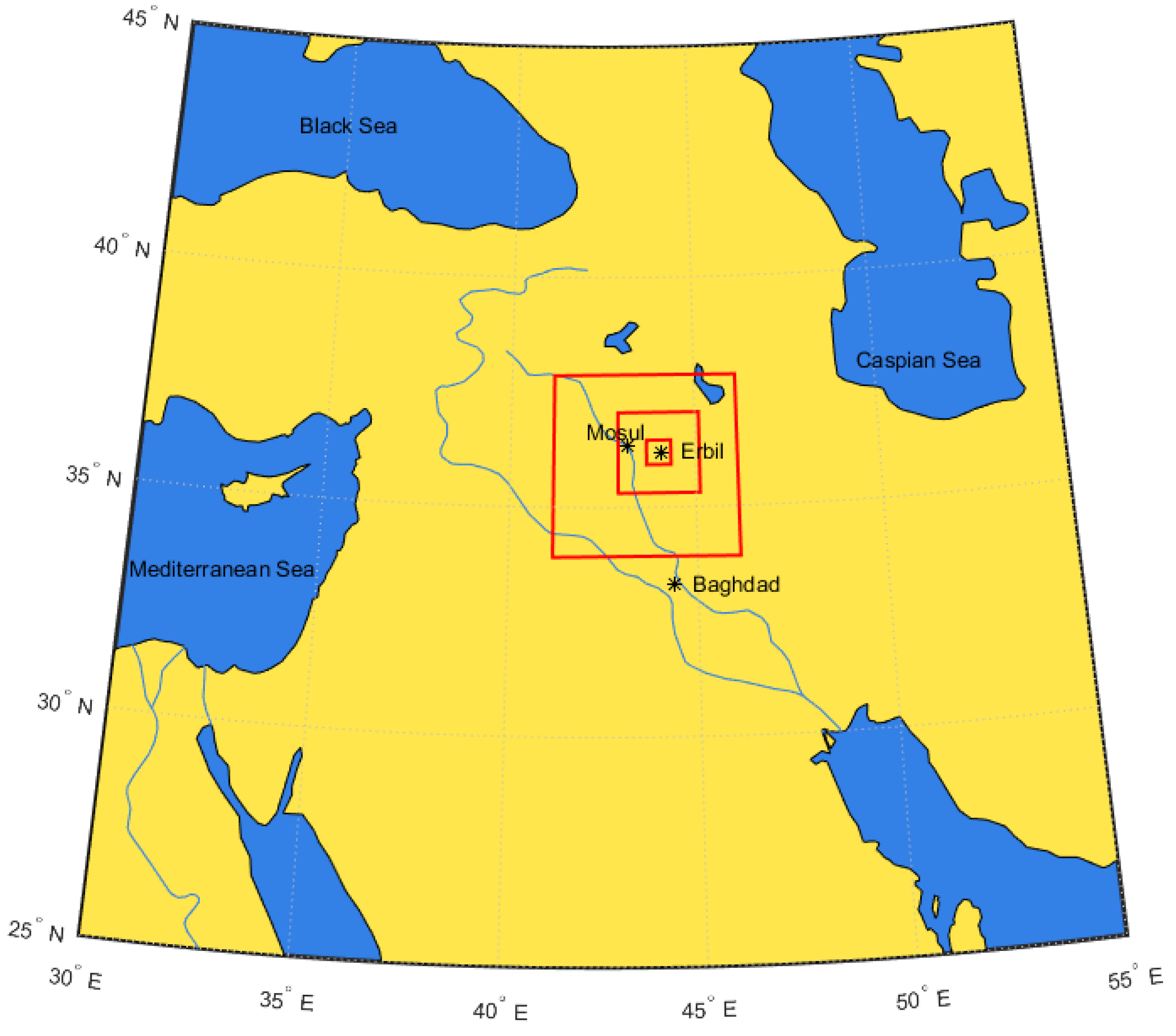
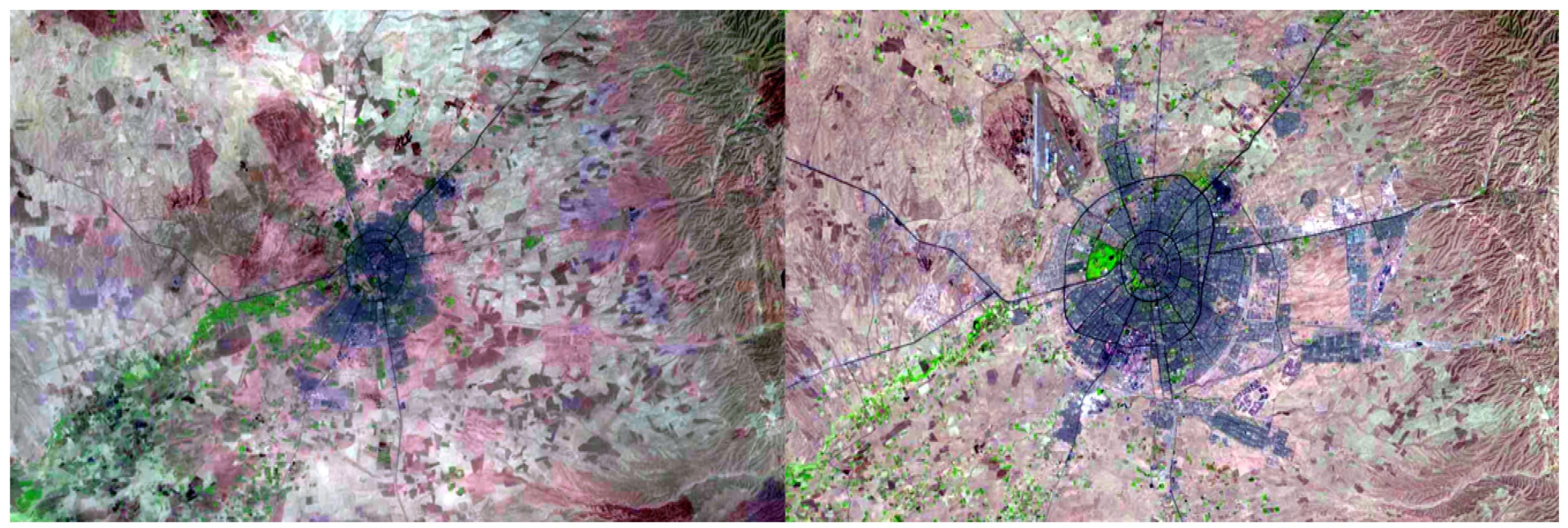



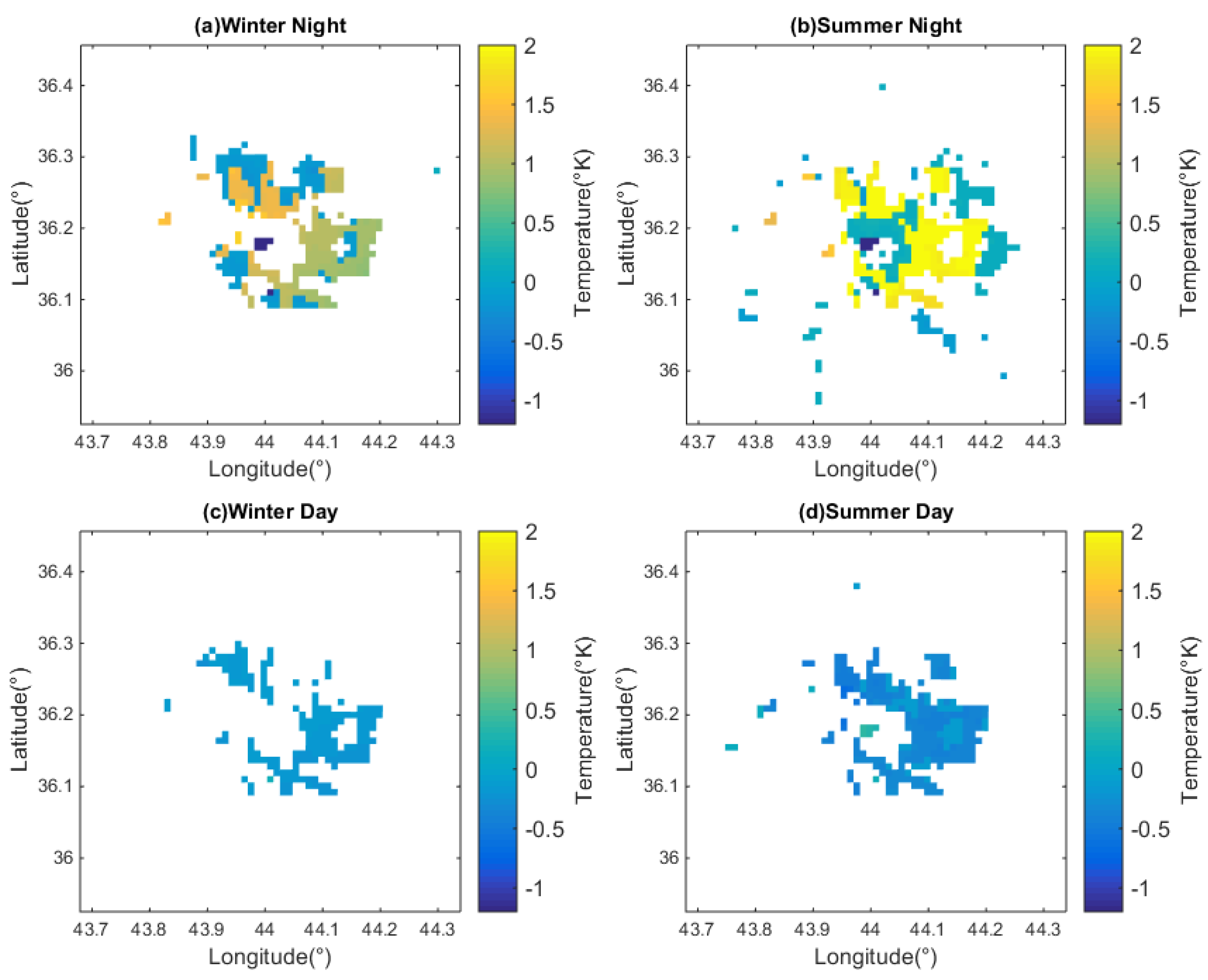

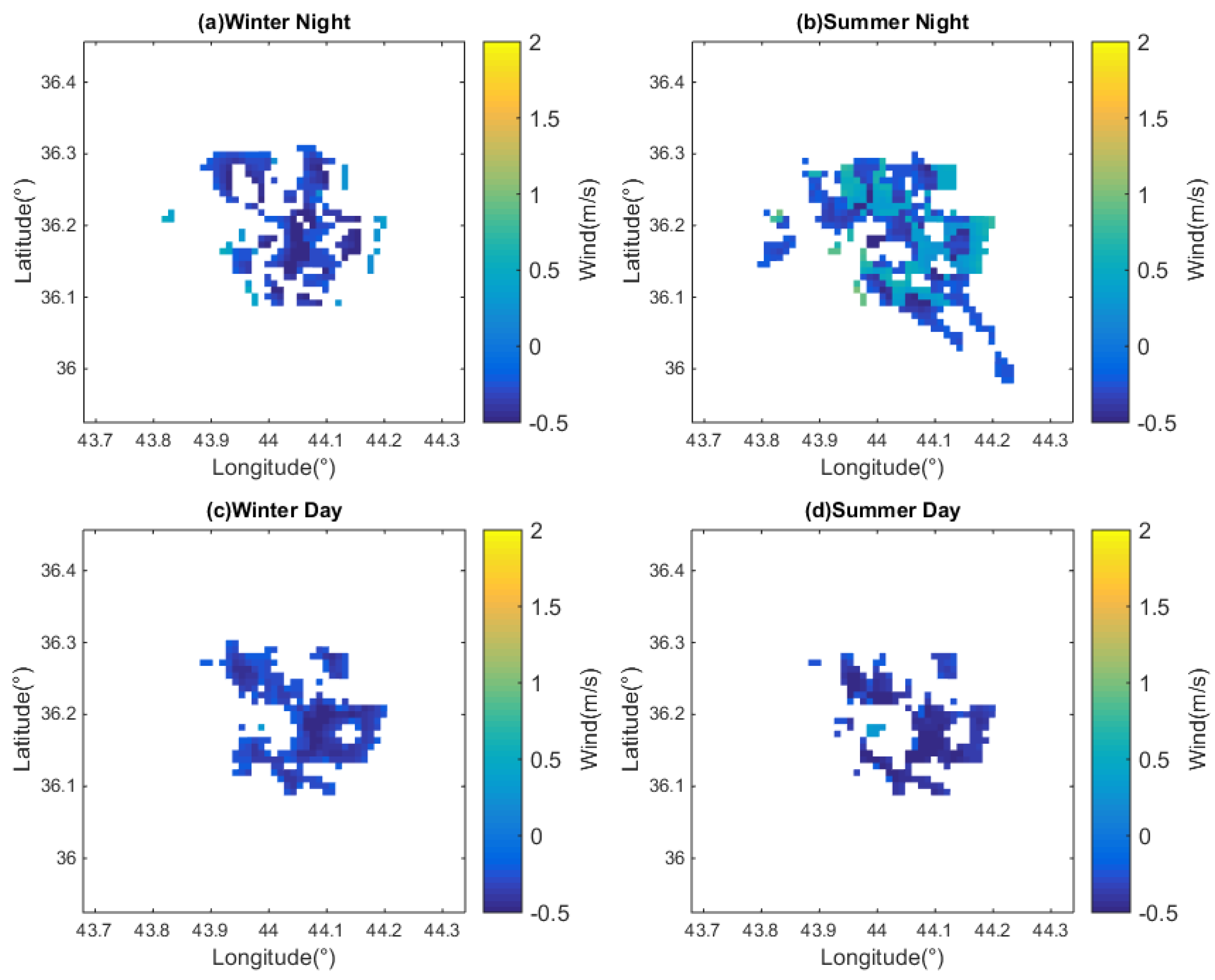
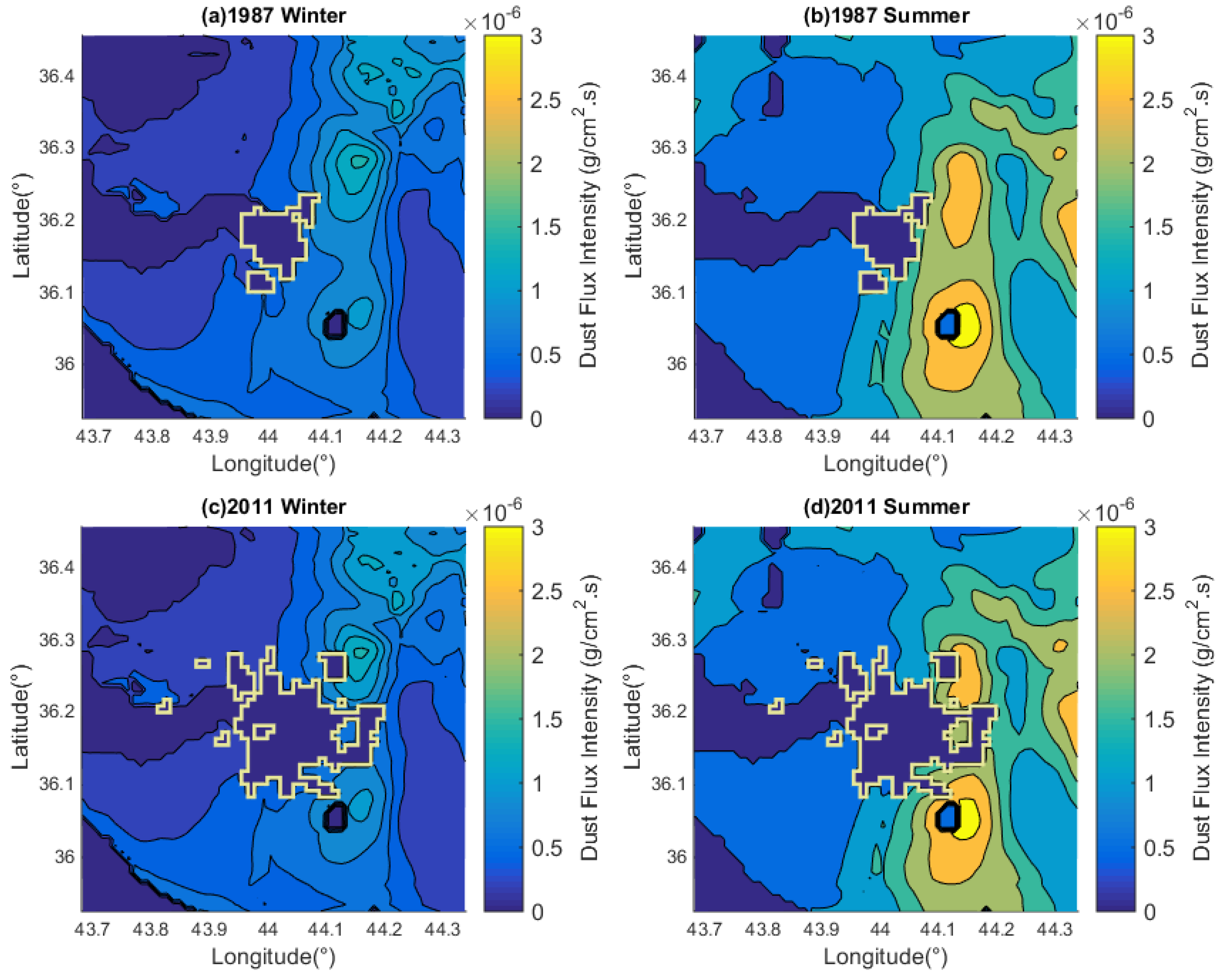
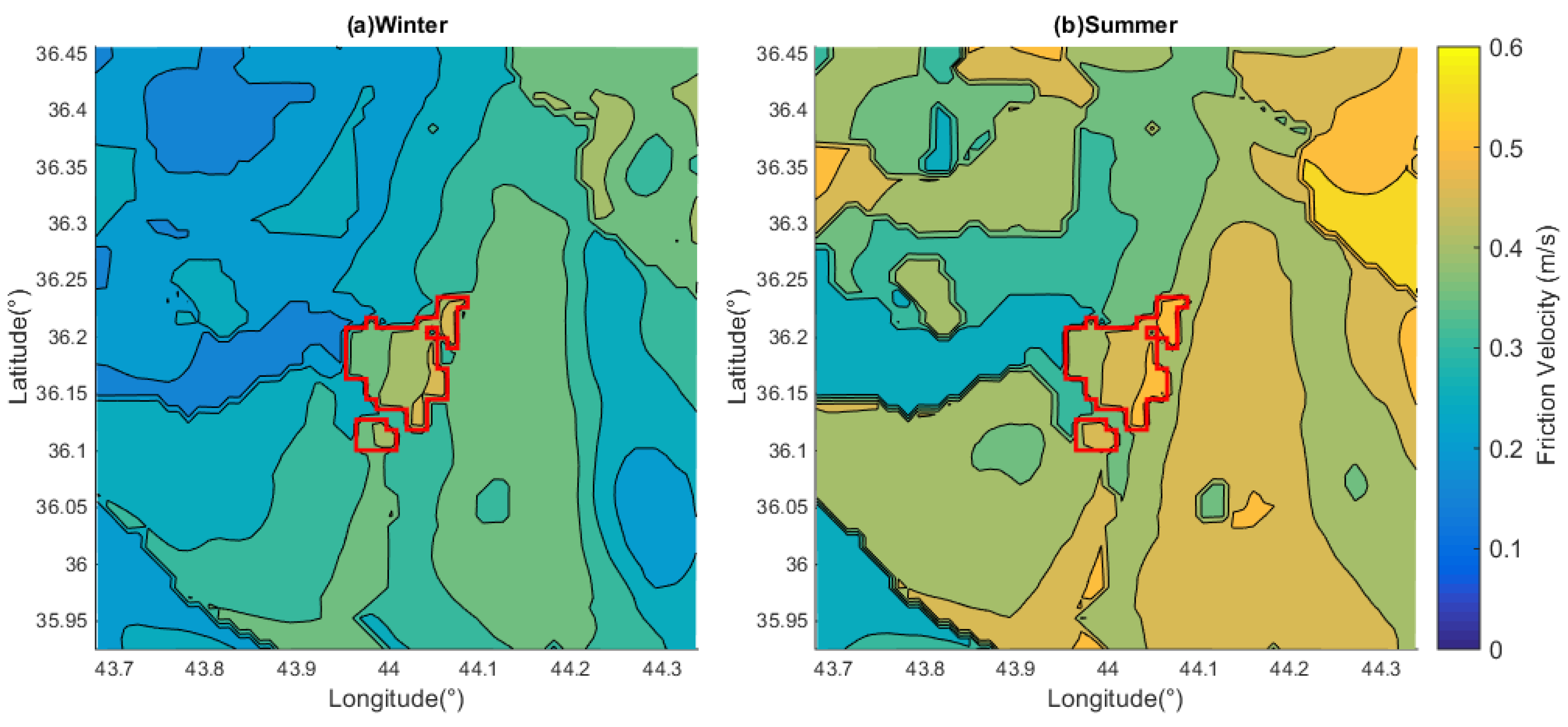
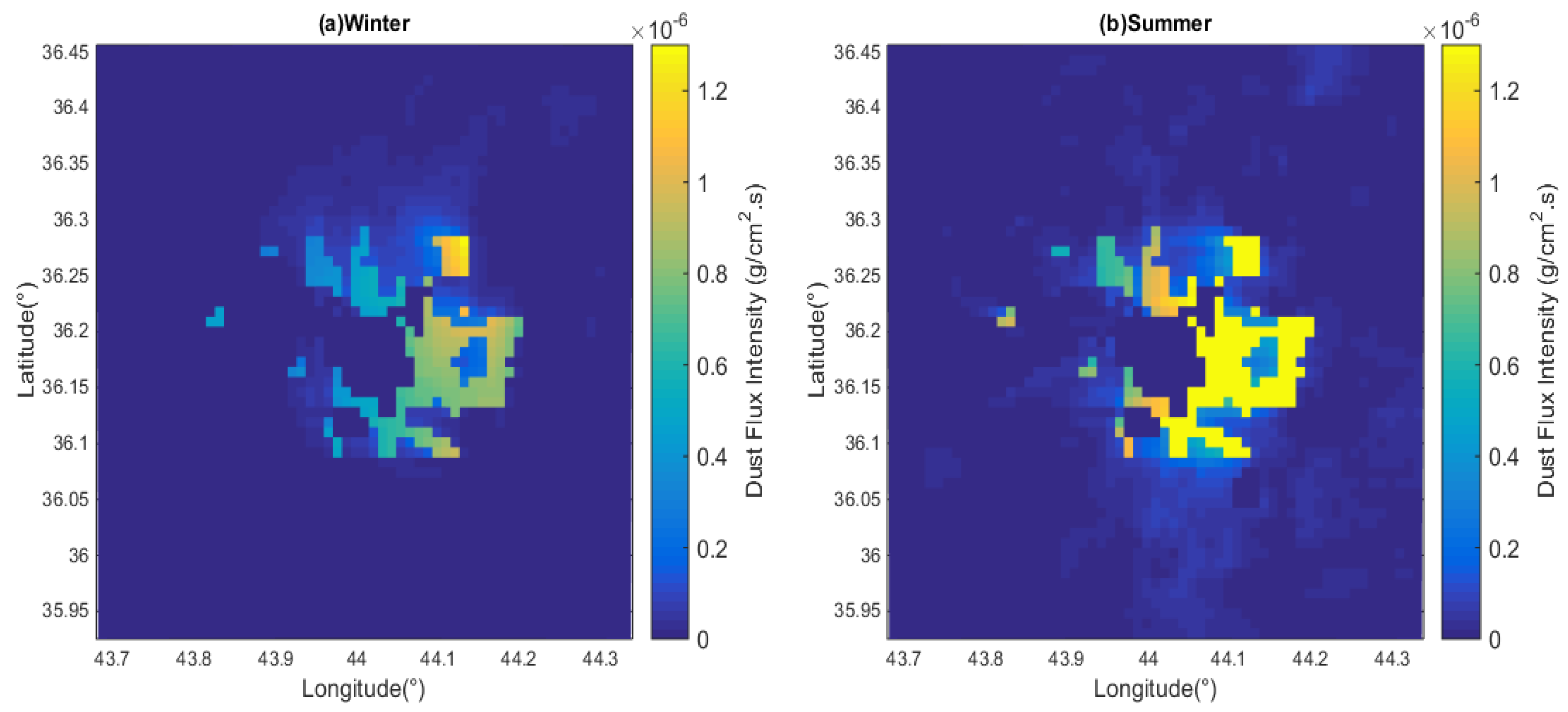
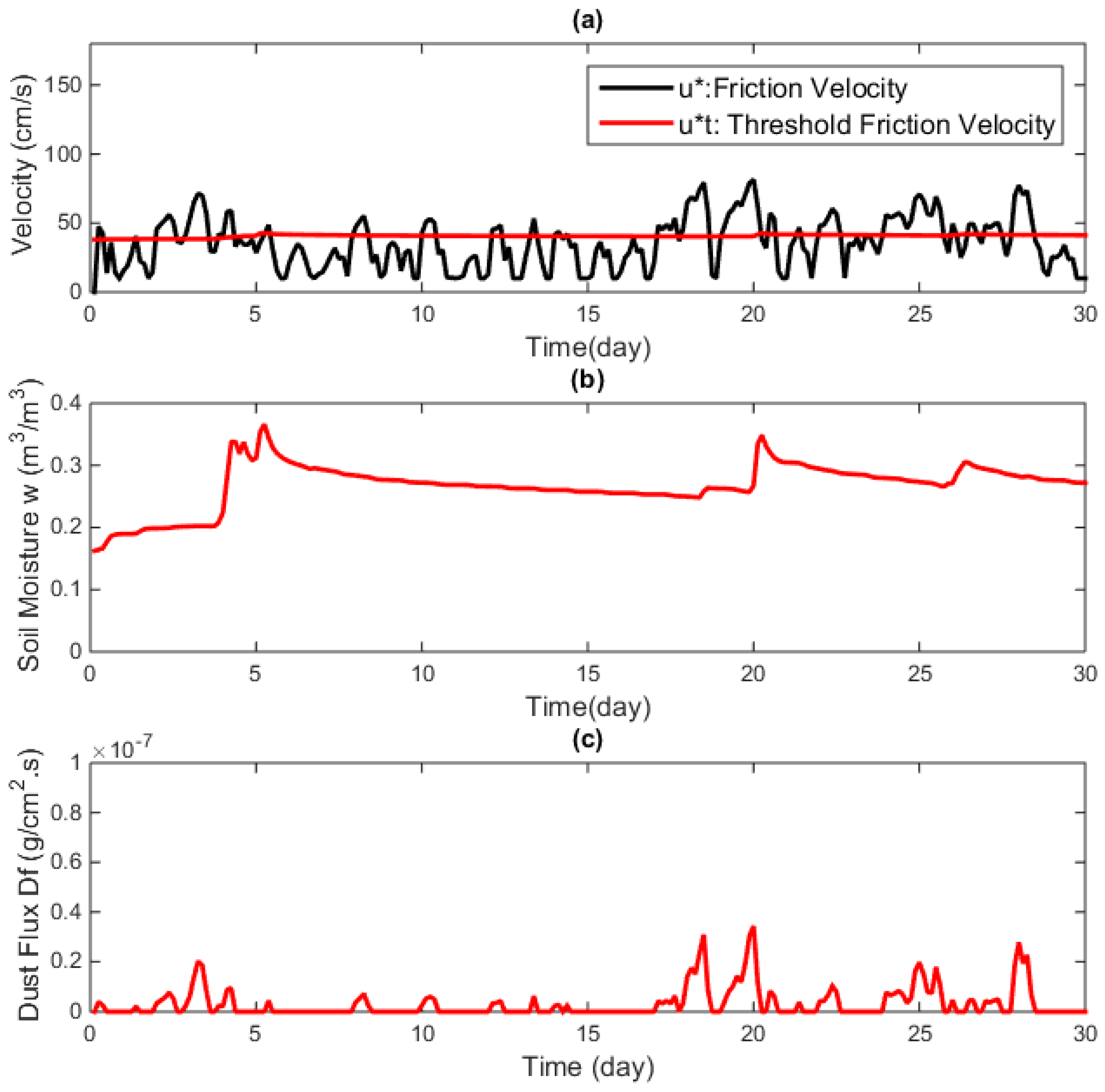
| No. | Description | Z0(cm) | Reduction Factor (R) |
|---|---|---|---|
| 1 | Urban and built-up land | 100 | 1.0 |
| 2 | Dry cropland and pasture | 2 | 0.4 |
| 3 | Irrigated cropland and pasture | 2 | 0.6 |
| 4 | Mixed dry/irrigated cropland and pasture | 2 | 0.5 |
| 5 | Cropland/grassland | 2 | 0.5 |
| 6 | Cropland/woodland | 2 | 0.7 |
| 7 | Grassland | 2 | 0.6 |
| 8 | Shrubland | 3 | 0.7 |
| 9 | Mixed shrub/grassland | 3 | 0.75 |
| 10 | Savanna | 2 | 0.8 |
| 11 | Deciduous broadleaf forest | 5 | 0.9 |
| 12 | Deciduous needleleaf forest | 5 | 0.9 |
| 13 | Evergreen broadleaf forest | 5 | 0.9 |
| 14 | Evergreen needleleaf forest | 5 | 0.9 |
| 15 | Mixed forest | 5 | 0.9 |
| 16 | Water | 0.1 | 1.0 |
| 17 | Herbaceous wet land | 0.2 | 1.0 |
| 18 | Wooded wet land | 0.3 | 1.0 |
| 19 | Barren or sparsely vegetated land | 1 | 0.1 |
| 20 | Herbaceous tundra | 0.3 | 1.0 |
| 21 | Wooded tundra | 0.3 | 1.0 |
| 22 | Mixed tundra | 0.2 | 1.0 |
| 23 | Bare ground tundra | 0.1 | 1.0 |
| 24 | Snow or ice | 0.1 | 1.0 |
| Run # | Land-Use Land-Cover for Surface B.C. | Lateral B.C. at the Outermost Domain | Output Frequency (h) | Duration (Days) |
|---|---|---|---|---|
| 1 | Erbil 1987 | 6-hourly FNL January 2000 | 3 | 30 |
| 2 | Erbil 2011 | 6-hourly FNL January 2000 | 3 | 30 |
| 3 | Erbil 1987 | 6-hourly FNL July 2000 | 3 | 30 |
| 4 | Erbil 2011 | 6-hourly FNL July 2000 | 3 | 30 |
© 2020 by the authors. Licensee MDPI, Basel, Switzerland. This article is an open access article distributed under the terms and conditions of the Creative Commons Attribution (CC BY) license (http://creativecommons.org/licenses/by/4.0/).
Share and Cite
Tahir, S.T.; Huang, H.-P. Modeling the Effect of Desert Urbanization on Local Climate and Natural Dust Generation: A Case Study for Erbil, Iraq. Urban Sci. 2020, 4, 46. https://doi.org/10.3390/urbansci4040046
Tahir ST, Huang H-P. Modeling the Effect of Desert Urbanization on Local Climate and Natural Dust Generation: A Case Study for Erbil, Iraq. Urban Science. 2020; 4(4):46. https://doi.org/10.3390/urbansci4040046
Chicago/Turabian StyleTahir, Sherzad T., and Huei-Ping Huang. 2020. "Modeling the Effect of Desert Urbanization on Local Climate and Natural Dust Generation: A Case Study for Erbil, Iraq" Urban Science 4, no. 4: 46. https://doi.org/10.3390/urbansci4040046




